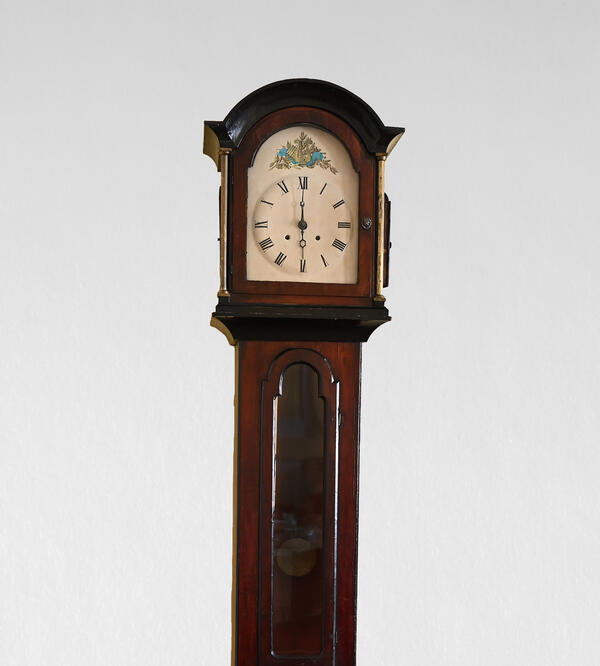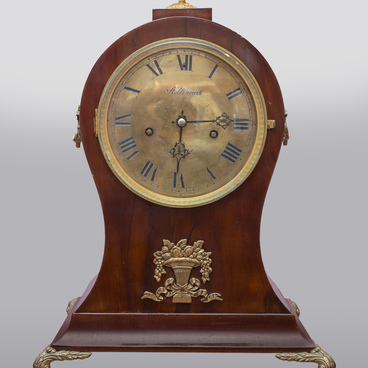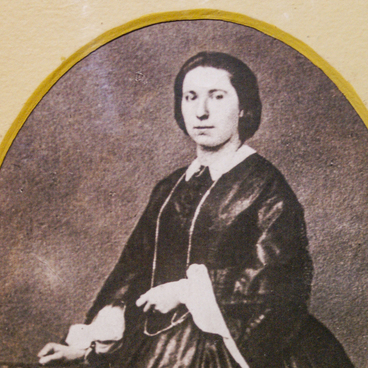Experts were not able to establish how this grandfather clock entered the Museum Estate. Researchers suggest that it was made by Votkinsk cabinetmakers who were commissioned by one of the wealthy local families.
The clock case is made of hardwood which was tinted to imitate mahogany. The case is made in the form of a multi-tier, elongated cabinet. The clock mechanism is located in the upper part with an arched top behind the glass door. The middle part of the cabinet is narrowed; the pendulum and weights are located inside it, behind the high glass door. The lower part is made in the form of a simple pedestal which rests on a wide plinth.
The rectangular clock face features a semi-circular arch at the top. It is made of wood and painted white. Musical instruments are depicted in the upper semi-arch against a background of laurel branches and flags.
This clock type appeared in the first half of the 19th century in Schwarzwald (the Black Forest region in Germany). They were called Holzgespindelt Lackschilduhr, which literally means ‘a clock with a painted dial and wooden axes’. Their circuit design was typical for German clocks of the first half of the 19th century: they were distinguished by two weight-driven mechanisms which had to be wound weekly and a half-hour striking mechanism with a counting wheel. Such clocks sounded every hour with the corresponding number of strikes on the bell located at the top of the mechanism.
It is not known who originally started the Schwarzwald clockmaking tradition; nevertheless, researchers adhere to two popular versions. According to the first one, the first wooden clocks were made by monks of the Abbey of St. Peter in Oudenburg in 1683. According to the other version, they were made in 1667 by the Kreutz family, who lived near the town of Waldau.
By the middle of the 19th century, Germany had become the leader in the production of big clocks and clock mechanisms. At the same time, the style ‘Gross Uhren’ was formed. Large grandfather clocks in this style, which quickly became more popular than English and French models and were characterized by the height, straight lines of the case and transparent ‘cabinet’ doors through which one could see the weights and the pendulum. Inexpensive Schwarzwald clocks were very popular in Russia as well.
The clock case is made of hardwood which was tinted to imitate mahogany. The case is made in the form of a multi-tier, elongated cabinet. The clock mechanism is located in the upper part with an arched top behind the glass door. The middle part of the cabinet is narrowed; the pendulum and weights are located inside it, behind the high glass door. The lower part is made in the form of a simple pedestal which rests on a wide plinth.
The rectangular clock face features a semi-circular arch at the top. It is made of wood and painted white. Musical instruments are depicted in the upper semi-arch against a background of laurel branches and flags.
This clock type appeared in the first half of the 19th century in Schwarzwald (the Black Forest region in Germany). They were called Holzgespindelt Lackschilduhr, which literally means ‘a clock with a painted dial and wooden axes’. Their circuit design was typical for German clocks of the first half of the 19th century: they were distinguished by two weight-driven mechanisms which had to be wound weekly and a half-hour striking mechanism with a counting wheel. Such clocks sounded every hour with the corresponding number of strikes on the bell located at the top of the mechanism.
It is not known who originally started the Schwarzwald clockmaking tradition; nevertheless, researchers adhere to two popular versions. According to the first one, the first wooden clocks were made by monks of the Abbey of St. Peter in Oudenburg in 1683. According to the other version, they were made in 1667 by the Kreutz family, who lived near the town of Waldau.
By the middle of the 19th century, Germany had become the leader in the production of big clocks and clock mechanisms. At the same time, the style ‘Gross Uhren’ was formed. Large grandfather clocks in this style, which quickly became more popular than English and French models and were characterized by the height, straight lines of the case and transparent ‘cabinet’ doors through which one could see the weights and the pendulum. Inexpensive Schwarzwald clocks were very popular in Russia as well.



